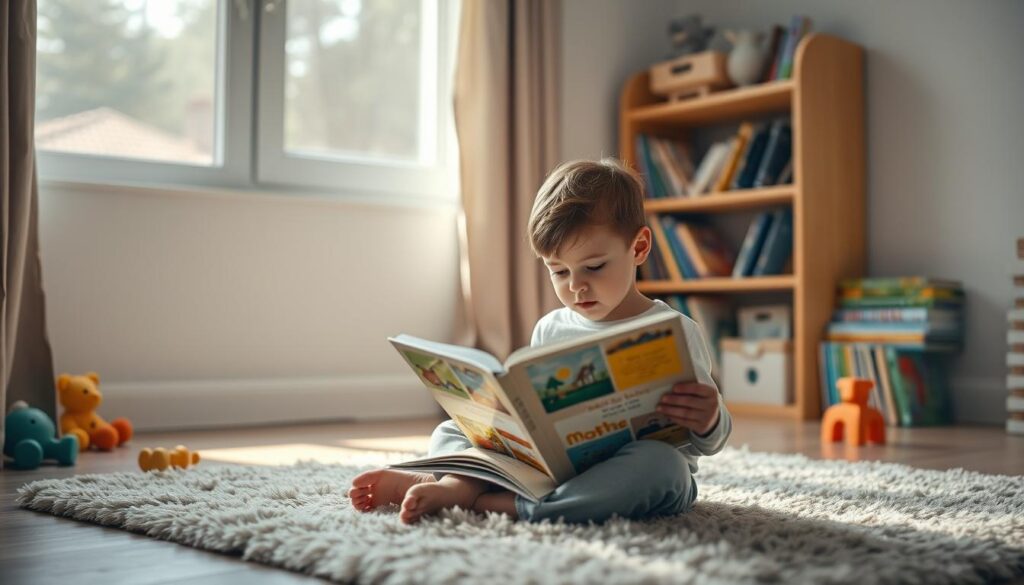Have you ever wondered why your child insists on rereading the same book over and over again? Is it just a phase, or is there something more to it? As a parent, it’s natural to feel a bit puzzled when your little one begs for the same story multiple times a day.
Research shows that rereading favorite stories plays a significant role in a child’s cognitive, emotional, and social development. In fact, studies have found that the more children engage with a story, the more they take away from it, including picking up new information and making connections.
As we explore the world of repetitive reading, you’ll discover how this simple act can become a powerful tool for early learning and bonding. So, let’s dive into the fascinating world of repeated readings and uncover the secrets behind your child’s love for their favorite stories.
Why Young Children Crave “Read It Again!”
As a parent, you’ve likely heard the familiar refrain of “read it again!” from your young child, but have you ever wondered what’s behind this repetitive request? This behavior is not just a quirk; it’s a fundamental aspect of howyoung childrenlearn and develop.
The Science Behind a Child’s Love for Repetition
During the timeframe of 1.5-5 years, achild’s braindevelops more than at any other time in life.Childrenare born with all the brain cells they’ll have, but it’s theconnectionsformed between those neurons that make thebrainwork. Repetition helps forge theseconnectionsmore strongly, supportingbrain development. You can explore more about supporting your child’s reading habits on our recommended reading duration page:https://lunesia.app/minutes-child-read-nightly/.
How Repetition Supports Brain Development
Repetition is crucial forchildrenas it provides a sense of control and security in an often unpredictableworld. By repeatedly reading the same story,young childrencan test boundaries, build trust, and strengthen neural pathways. Thisrepetitive readingbehavior is a natural instinct that aids in theirjourneyof learning and growth.
Cognitive Benefits of Repetitive Reading for Young Children
Repetitive reading is more than just a favorite pastime for young children; it’s a crucial element in their cognitive development. As a parent, reading the same story multiple times might seem mundane, but it’s actually a powerful tool for enhancing your child’s learning and language skills.
Building Vocabulary Through Repeated Exposure
When children are exposed to the same story repeatedly, they learn new words more effectively. Research shows that children absorb vocabulary better through repeated exposure to a few words rather than brief exposure to many different words. This repeated exposure allows for deeper processing and integration of new vocabulary.
Enhancing Memory and Information Retention
Repetition plays a significant role in memory development, especially in young children. Since younger children need longer to encode information and tend to forget faster, repetition is essential for information retention. As you read the same story multiple times, your child gradually builds a comprehensive understanding of both content and language structure.
Recognizing Patterns and Language Structure
Repetitive reading helps children recognize patterns in language structure, which is crucial for understanding grammar and syntax. As children become familiar with the text, they begin to anticipate what’s coming next, enhancing their comprehension and language skills. You can explore more bedtime stories to keep the reading experience engaging.
As you continue reading the same story to your child, remember that the cognitive benefits extend far beyond simple memorization. Repetitive reading creates a foundation for lifelong learning and language mastery, fostering not just reading skills, but also speaking and writing abilities that will serve your child throughout their life.

Emotional and Social Benefits of Reading the Same Books
The act of reading the same book again and again to children fosters a deep sense of connection and emotional stability. This repetitive practice has several emotional and social benefits that are crucial for a child’s development.
Creating Security
Consistent and repetitive routines provide a sense of security for young children, promoting emotional stability. Predictable patterns help them feel in control of their environment, reducing anxiety and fostering a sense of safety.
Strengthening Bonds
The shared experience of reading the same book repeatedly creates a special bond between parent and child, establishing rituals and inside jokes that strengthen attachment. This secure attachment is crucial for emotional development and enhances a child’s ability to learn and retain information.
Building Confidence
As children master one book completely, they gain the confidence to explore new books, showing how repetition leads to greater independence and curiosity. Parents and caregivers who understand the emotional value of repetition can transform what might feel tedious into meaningful bonding opportunities.
Practical Ways to Make Repetitive Reading Engaging
To keep repetitive reading fresh, parents can employ several strategies that not only maintain their child’s interest but also enhance their learning experience. By incorporating creativity into reading sessions, parents can make the experience enjoyable for both themselves and their children.
Focus on Different Elements Each Time
During each reading session, focus on different elements of the book. For younger children, this could mean identifying colors or counting objects on a page. For older children, it might involve analyzing characters’ emotions or discussing the plot in more depth. This approach keeps the experience engaging and helps children develop various skills.

Make Real-Life Connections to the Story
Making connections between the story and your child’s life can deepen their understanding and make reading more meaningful. For example, if a character in the book is riding a train, you could remind your child of the time you rode a train together. This helps children bridge the gap between stories and their own experiences, enhancing comprehension and emotional engagement.
Gradually Introduce Variations and New Books
Once your child is familiar with a book, you can start introducing variations or new books on similar topics. Offering books by the same author or with similar themes can gently transition your child to new reading experiences while still providing a sense of continuity. This approach is particularly helpful for children who become attached to a single book.
| Strategy | Age Group | Benefits |
|---|---|---|
| Focusing on different elements | All ages | Develops various skills, keeps reading engaging |
| Making real-life connections | All ages | Enhances comprehension, emotional engagement |
| Introducing variations and new books | Older children | Transitions child to new reading experiences, maintains continuity |
Conclusion: Embracing the Power of “Again, Again!”
The power of “again, again!” lies in its ability to transform a simple reading experience into a rich, multi-layered journey for young children. By understanding the value of repetition, parents and caregivers can turn what might seem like a tedious task into a meaningful experience that fosters language development, memory, and understanding.
Repetitive reading isn’t just something kids enjoy; it’s a fundamental part of how they learn about language, the world around them, and even themselves. Each reading of the same book offers new opportunities for learning and connection, helping children make new connections and notice different elements.
By embracing this developmental need, you’re supporting your child’s journey toward becoming a confident, curious, and capable learner. So, the next time you hear “again, again!”, consider it an invitation to participate in one of the most effective and natural learning processes your child will experience.
FAQ
How does repetitive reading help my child’s language development?
Repetitive reading exposes your child to the same words and phrases, helping them build vocabulary and understand language patterns. As you read together, your child becomes familiar with the story, and their brain starts to make connections between the words and the world around them.
Will reading the same book multiple times bore my child?
Not necessarily! Repetition can be comforting for kids, and they often enjoy the predictability of a familiar story. You can make it more engaging by focusing on different elements each time, like pictures or characters, or making real-life connections to the story.
How does repetitive reading support my child’s brain development?
Repetition helps your child’s brain develop by creating new connections and strengthening existing ones. As they hear the same story multiple times, they’re able to recognize patterns and understand the story’s structure, which can improve their memory and information retention.
Can repetitive reading help my child become a more confident reader?
Yes! When your child is familiar with a story, they can start to “read” it on their own, even if they’re just pretending. This can help build their confidence and independence, as they feel more comfortable with the text and the story.
How can I keep repetitive reading engaging for my child?
Try to mix it up by focusing on different aspects of the story, like the pictures or the characters. You can also make connections to your child’s life, like pointing out how a character’s experience is similar to something they’ve gone through. This can help keep the story fresh and exciting!




